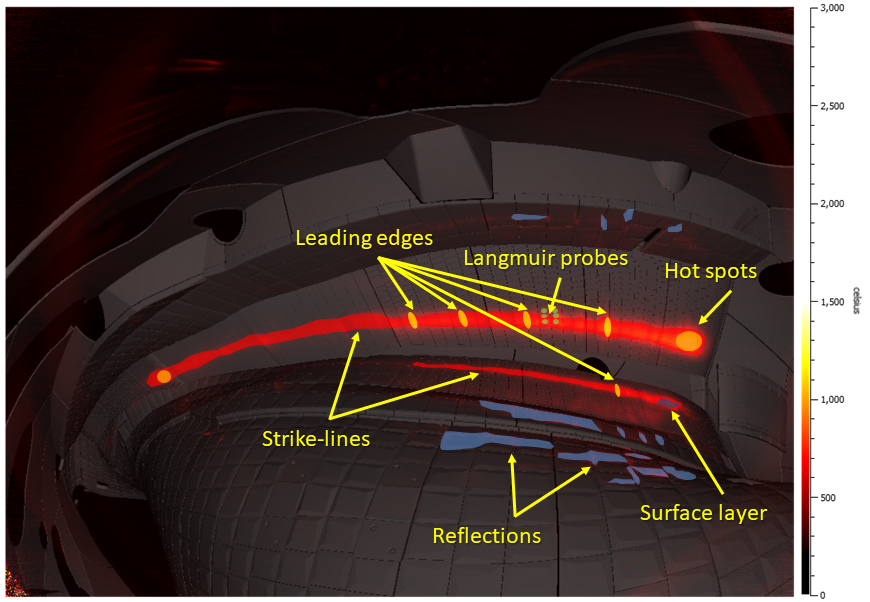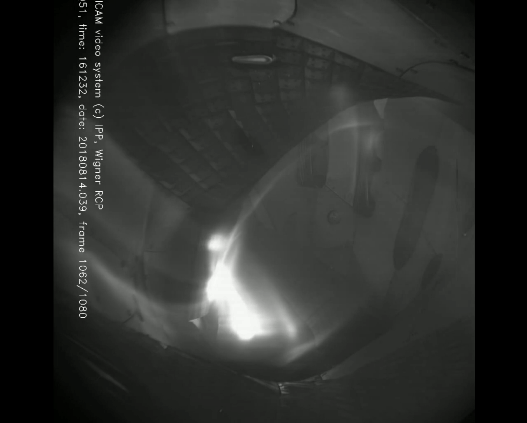Image processing for Plasma Facing Components protection

| Type | Start | End |
|---|---|---|
| European | Jan 2019 | Dec 2022 |
| Responsible | URL |
|---|---|
| Josep R. Casas | EUROfusion website |
Reference
EUROfusion ITER Physics WP S1: Preparation and Exploitation of W7-X Campaigns, P.2: Specific diagnostics, software and component reparation (Tasks S1.P2.T6-T7)
Description
This project is the result of a research collaboration with the Max Planck Institute for Plasma Physics (IPP) located in Greifswald (Germany) within the H2020 EUROfusion project where UPC is a LTP of CIEMAT.
Wendelstein 7-X is the largest prototype of a fusion reactor of the "Stellarator" family (see this piece of news for general information, and this spectacular 360º Virtual Tour Panorama of W7-X, where a mouse click leads you right into the plasma vessel or the experimentation hall and other facilities) . The first operation phase (OP1) started in 2017, and IPP offers now a large amount of the resulting data (videos, images) for research.

Fig.1 View of the Weldenstein 7-X coil System
The collaboration of GPI in this project is included in EUROfusion WPS1. The main purpose of WPS1 is the preparation, execution and exploitation of Wendelstein 7-X campaigns. In particular, the Project Project Management Plan 2019/20, foresees GPI contribution within Key milestone 1.3 in order to prepare and develop control and data acquisition systems and diagnostics addressing objectives for safe steady-state operation and employ surveillance diagnostics for the detection of wall loads, hot spots. The relevant objectives are grouped within task S1.P2.T6 Image Processing and Object Detection:
- S1.P2.T6 (a) Develop image processing and machine learning tools for detection, tracking and classification of thermal events on the Plasma Facing Components or PFCs (strike-lines, leading edges, hot spots, surface layers, delaminations, reflections), from thermal images that observe the plasma during operation.


Fig.2a Thermal events on PFCs (IR image) Fig.2b Animation sequence of a strike line - S1.P2.T6 (b) Develop a real-time NN-based heat flux THEODOR estimation for the real-time image analysis system for PFC protection.
- S1.P2.T6 (c) Develop image processing tools for video and Ha data analysis for automatic plasma events detection and their correlation with the magnetic topology. In this case, a different set of 10 visible camera sensors (EDICAMs @400fps) have observed anomalies in the plasma behavior that IPP has the challenge to study, classify and detect in the 50h of footage they have available. A first ontology of anomalies is: falling debris, MARVEs, Pellets, UFOs and hotspots.

Fig. 3 Anomaly in the reactor core: falling debris (EDICAM)
The results of the collaboration are to be reported the end of 2019 (S1.P.2.D6.1: Interim report on S1.P.2.T6) and 2020 (S1.P.2.D6.2: Final report S1.P.2.T6).
Internal reports resulting from the students who participate in the collaboration are as follows:
- in progress:
- D. Vizcarro Carretero, “Thermal Image Processing for Plasma Facing Components protection,” Degree Thesis, ETSETB-UPC
- J.-H. Kim Jung, “Spatial Map for Thermal Image Processing at Wendelstein 7-X,” Degree Thesis, ETSETB-UPC
- A. Palacios Corral, “Automatic detection of visible events in fusion reactors,” MsTh Master in Advanced Telecommunication Technologies, ETSETB-UPC - L. Cabello Quelart, “Tracking and classification of anomalies in Wendelstein 7-X fusion reactor,” Degree Thesis (en), ETSETB-UPC, Barcelona, 28-Oct-2020
- R. Clemente Bonjour, “Detection, tracking and classification of thermal events on Plasma Facing Components,” MsTh Master in Telecomunications Engineering ETETB-UPC 9-Sep-2020
- M. Cobos Arnalot, “Anomalies detection in the visible spectrum of Plasma Physics at Wendelstein 7-X,” MsTh Master in Computer Vision, UAB-UPC-UPF-UOC, Barcelona, 20-Jul-2020
- A. Cano Aguilera, “Anomaly detection using Computer Vision for fusion power generation,” Degree Thesis, ETSETB-UPC, Barcelona, 17-Jul-2020
- S. Quiceno, “Detection of hot spots and heat lines in thermal images of a nuclear fusion reactor,” Degree Thesis (es), ETSETB-UPC, Barcelona, 6-Feb-2020
- A. Moreno, “Thermal events detection in the infrarred Spectrum at Wendelstein 7-X,” Degree Thesis (en), ETSETB-UPC, Barcelona, 5-Feb-2020
- A. Palacios Corral, “Anomalies detection in the infrared spectrum of Plasma Physics at Wendelstein 7-X,” Degree Thesis (cat), ETSETB-UPC, Barcelona, 1-Jul-2019
Other contributors:
- Ivan Caminal, technical support (Apr-Nov 2019)
Publications
|
. Experimental confirmation of efficient island divertor operation and successful neoclassical transport optimization in Wendelstein 7-X. Nuclear Fusion. 2022 ;62(4). |
|
. Real-time detection of overloads on the plasma-facing components of Wendelstein 7-X. Applied sciences (Basel). 2021 ;11(24). |
| . Spatio-temporal Detection and Tracking of Thermal Events on the Plasma Facing Components of Wendelstein 7-X. In: 4th IAEA Technical Meeting on Fusion Data Processing, Validation and Analysis. 4th IAEA Technical Meeting on Fusion Data Processing, Validation and Analysis. Shanghai (online): iaea.org; 2021. |
|
Real-time detection of overloads on the PFCs of W7-X. In: European Conference on Plasma Diagnostics (ECPD 2021). European Conference on Plasma Diagnostics (ECPD 2021). online: CLPU; 2021. |
| Strategy for the real-time detection of thermal events on the plasma facing components of Wendelstein 7-X. In: 31st Symposium on Fusion Technology (SOFT2020). 31st Symposium on Fusion Technology (SOFT2020). Dubrovnik, Croatia; 2020. |
Collaborators
| Josep R. Casas | Associate Professor | josep.ramon.casas@upc.edu |
| Philippe Salembier | Professor | philippe.salembier@upc.edu |
| Josep Ramon Morros | Associate Professor | ramon.morros@upc.edu |
